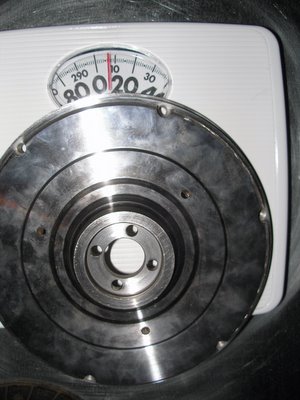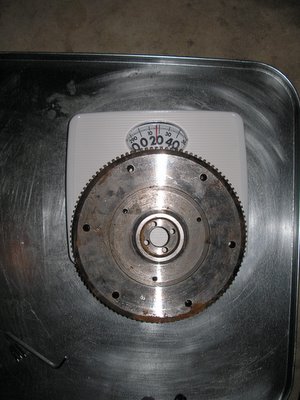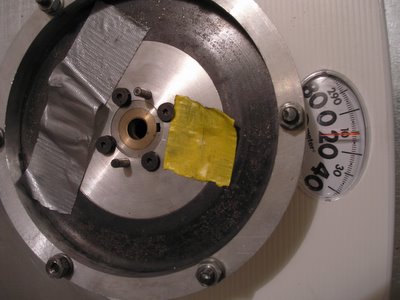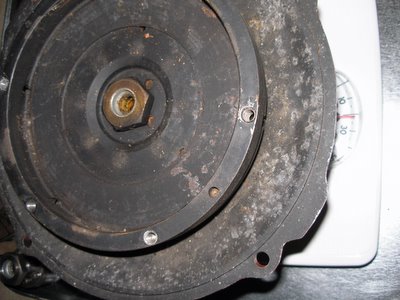A Flock of Flywheels
With no reciprocating parts to cause vibration and plenty of mass in the rotating commutator, electric car motors need no flywheel to provide smooth power. However, if using a transmission and you want a clutch for smooth and speedy gearshifts, there must be a pressure plate and the associated hardware. Since every additional pound of rotating mass cuts into acceleration as much as almost 10 lbs of weight elsewhere on the vehicle, keeping flywheel weight to a minimum is important for optimal EV performance. A stock Type I VW flywheel, as shown below, weighs about 17 lb on my bathroom scale-o-riffic. After being attacked by a zealous machinist, that unwieldy piece of German chromoly steel came in under 7 pounds!


For additional perspective, let's look at the respective undersides. There's a lot of missing meat there, but none where it was needed! A note for safety- we're dealing here with an OEM German forged cromoly steel wheel here, not a cheap cast repro. Nothing less than the best can be lightened to such extremes and still be safely counted on to stay together under pressure.

Satisfied that my flywheel situation had been solved, albeit expensively (shaving this much steel consumed three lathe cutter heads, at machinist-by-the-hour pricing!), only then did I happen upon a unique EV goodie. The original Kaylor-kit is a 1970's piece of EV history; a cast aluminum adaptor plate that contains a bearing and splined shaft adaptor to mate a WWII era aircraft starter-generator to the VW transaxle. I previously spent over a year searching for one of these babies in hopes of getting started in the EV hobby cheaply, and also for the thrill of an old-school contactor-controlled conversion. I would've liked to learn along the same curve that the current gurus of the hobby did. HowEVer, the Kaylor plate proved difficult to find, and those that were offered for sale were prized a bit too preciously by their owners. Of course, once I turned down the modern path, I happened upon this never-used Kaylor Kit in the hands of a fellow VW owner who was only too happy to salvage a few bucks out of his orphaned antique project... And what did that Kaylor plate include, but a shaved-down VW flywheel! (Though this flywheel weighs in at an obese nine pounds, it's always nice to have a spare- until my next conversion!)
The last flywheel I'll mention was actually the first acquisition. This tidy piece of engineering is a Bob Batson (EV America) design, and it's innovative feature is a flywheel replacement built right into the adaptor. A simple steel disc is sandwiched between aluminum rings, providing for the lightest package of all, barely weighing 12 pounds, flywheel, hub, nuts and bolts and all (duct tape is holding the woodruff key and setscrews). The only weak spot in this approach is that it relies upon a pair of setscrews to keep the assembly centered and squeezed tight. This approach should work fine for a commuter conversion, but the "wisdom of the list" convinced me that one of Electro Automotive's bulletproof taperlock adaptor hubs was the way to go for smooth transfer of high power. Not only does the taperlock design ensure a perfectly centered, vibration-free assembly, but it guarantees not to be the weakest link. 
The Electro Auto taperlock adaptor is deceptively simple, machined from a donor crankshaft. Mine arrived with a rather primitive appearance, as the cast-in oil journals were sliced through during machining, leaving rough pockmarks in the hub's surface. However, this wedgemated hunk of steel is certain to give the tightest connection practical between motor and flywheel.







